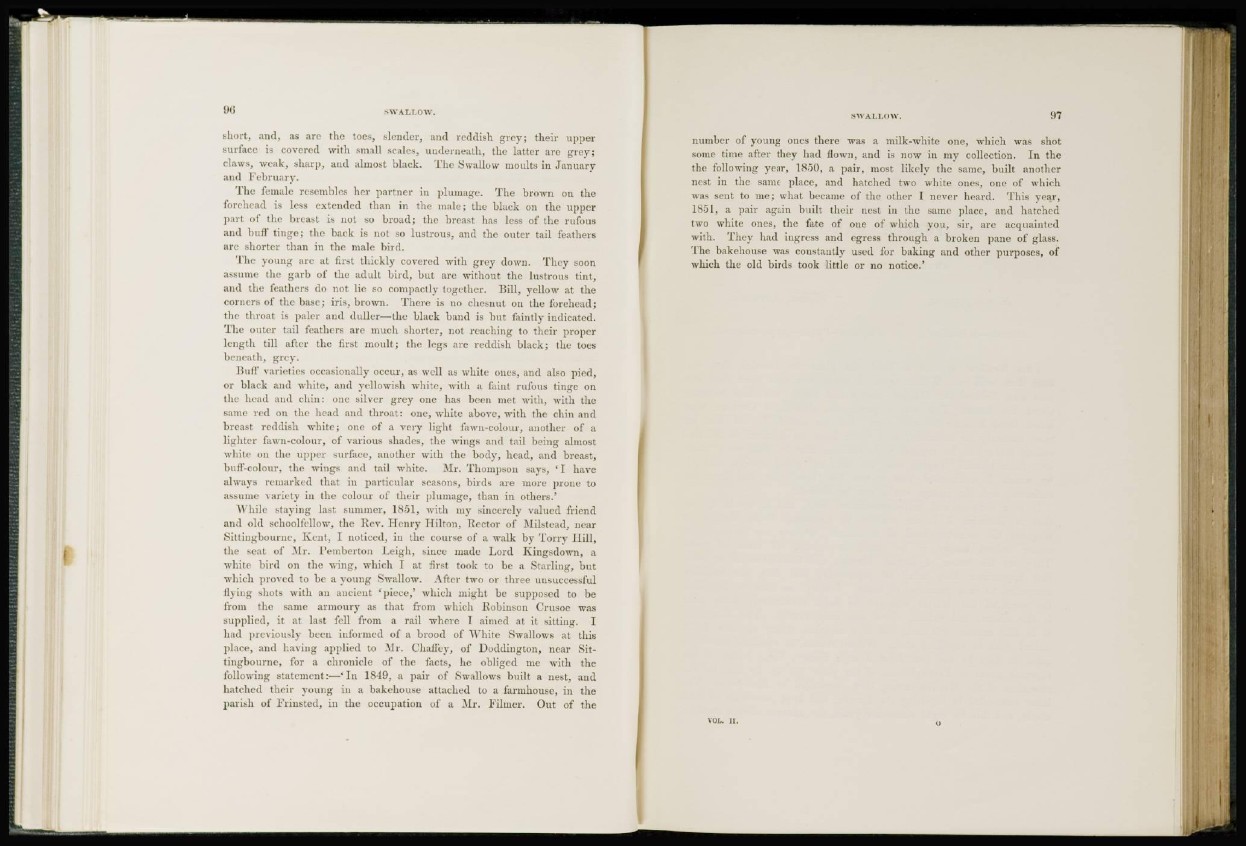
short, and, as are the toes, slender, and reddish grey; their upper
surface is covered with small scales, underneath, the latter are grey;
claws, weak, sharp, and almost black. The Swallow moults in January
and February.
The female resembles her partner in plumage. The brown on the
forehead is less extended than in the male; the black on the upper
part of the breast is not so broad; the breast has less of the rufous
and buff tinge; the back is not so lustrous, and the outer tail feathers
are shorter than in the male bird.
The young arc at first thickly covered with grey down. They soon
assume the garb of the adult bird, but arc without the lustrous tint,
and the feathers do not lie so compactly together. Bill, yellow at the
corners of the base; iris, brown. There is no chesnut on the forehead;
the throat is paler and duller—the black band is but faintly indicated.
The outer tail feathers are much shorter, not reaching to their proper
length till after the first moult; the legs are reddish black; the toes
beneath, grey.
Buff varieties occasionally occur, as well as white ones, and also pied,
or black and white, and yellowish wdiite, with a faint rufous tinge on
the head and chin: one silver grey one has been met with, with the
same red on the head and throat: one, white above, with the chin and
breast reddish white; one of a very light fawn-colour, another of a
lighter fawn-colour, of various shades, the wings and tail being almost
white on the upper surface, another with the body, head, and breast,
buff-colour, the wings and tail white. Mr. Thompson says, *I have
always remarked that in particular seasons, birds are more prone to
assume variety in the colour of their plumage, than in others.'
While staving last summer, 1851, with my sincerely valued friend
and old schoolfellow, the Rev. Henry Hilton, Rector of Milstead, near
Sittingbourue, Kent, I noticed, in the course of a walk by Torry Hill,
the seat of Mr. IVmberton Leigh, since made Lord Kingsdown, a
white bird on the wing, which I at first took to be a Starling, but
which proved to be a young Swallow. After two or three unsuccessful
Hying shots with an ancient 'piece/ which might be supposed to be
from the same armoury as that from which Robinson Crusoe was
supplied, it at last fell from a rail where I aimed at it sitting. I
had previously been informed of a brood of White Swallows at this
place, and having applied to Mr. Chaffey, of Doddington, near Sittingbournc,
for a chronicle of the facts, he obliged me with the
following statement:-—'In 1849, a pair of Swallows built a nest, and
hatched their young in a bakehouse attached to a farmhouse, in the
parish of Frinsted, in the occupation of a Mr. Filmer. Out of the
number of young ones there was a milk-white one, which was shot
some time after they had flown, and is now in my collection. In the
the following year, 1850, a pair, most likely the same, built another
nest in the same place, and hatched two white ones, one of which
was sent to me; what became of the other I never heard. This year,
1851, a pair again built their nest in the same place, and hatched
two white ones, the fate of one of which you, sir, are acquainted
with. They had ingress and egress through a broken pane of glass.
The bakehouse was constantly used for baking and other purposes, of
which the old birds took little or no notice.'
VOL. II.